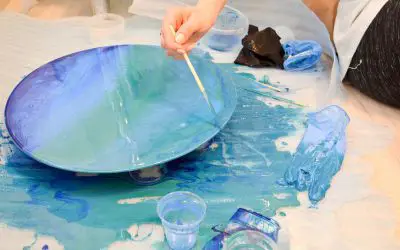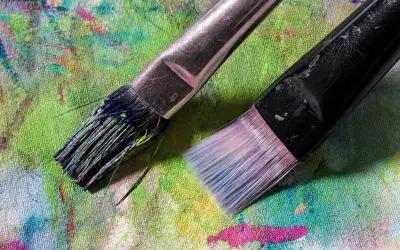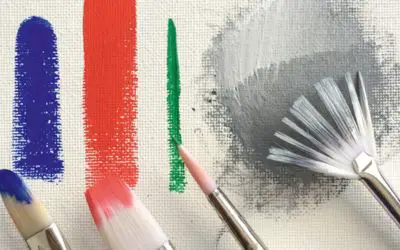Do you wet the brush before using acrylic paint? This is a simple question, yet it holds the key to unlocking some of the most fascinating aspects of painting.
From determining the paint’s texture to ensuring your brush’s longevity. The answer has several implications.
Acrylic painting is popular for its versatility, durability, and vibrant color range.
But, you may need clarification about the right process to use acrylic paints, especially in brush preparation.
Understanding these aspects can contribute to a more enjoyable and successful painting experience.
Read on to explore the answer in an easy-to-understand manner.
Do You Wet the Brush Before Using Acrylic Paint?
Wetting the brush before using acrylic paint can enhance paint application. The bristles become slightly moist by dipping the brush in water, enabling smoother paint gliding. It is optional for the brush to be soaking wet.
How to Wet the Brush Before Using Acrylic Paint?
Step 1: Select the right brush
Acrylic paint is best suited for synthetic brushes with stiff bristles. The brushes should maintain their shape, such as nylon or polyester brushes.
Do not use natural hair brushes when you paint because they will take in the moisture from the paint and change shape.
Step 2: Gather the necessary materials
You will need a cup of clean water and your chosen paintbrush. Place the cup on a flat, stable surface within easy reach.
Step 3: Prepare a container of water
Fill the cup with lukewarm water, up to about two-thirds full. Avoid using too much water, as it could complicate the application process.
Step 4: Wet the brush
Dipping the brush into the water ensures it is submerged. Swirl it around to disperse the paint and let it sit for a few seconds.
Wetting the brush help to soften the bristles, rendering them more flexible and easy to manipulate.

Step 5: Remove excess water
After swishing the brush in the water, remove it from the cup. Shake off any excess water and use a clean rag or paper towel to blot it dry.
Step 6: Ready for painting
To start painting with acrylics, ensure the brush is free of excess moisture.
Rinse the brush in fresh water when switching colors to maintain its condition and ensure the paint remains thick.
Avoid dipping the paintbrush directly into the jar of acrylic paint, as it can result in a messy appearance and uneven coverage in your artwork.
Advantages of Wet Brush for Applying Acrylic Paint
Wetting the brush before applying acrylic paint offers several advantages:
- Smoother paint application: Wetting the brush enhances the mobility of the paint. Employing a paint roller contributes to achieving an even and smooth finish. Such methods simplify the process of regulating the quantity of paint applied.
- Improved blending and layering: Adding water to the brush helps the acrylic paint spread and mix better. It enables colors to mix more easily, creating seamless transitions and gradients.
- Enhanced control over paint flow: Wet paint brushes keep a certain moisture level. The moisture impacts the viscosity of the paint, resulting in slight thinning and improved control.
- Extended working time: Acrylic paint limits blending due to its quick-drying nature. To extend working time, wet your brush before painting to allow for more color mixing on the canvas before drying.
- Facilitates paint adherence: A damp brush helps the paint adhere to the canvas. It ensures better coverage and reduces the chances of patches in your artwork.
- Improved brush durability: Wetting the brush with water helps the brush last longer. It prevents the bristles from becoming hard, brittle, or matted due to dried paint.
- You can mix different colors of acrylic paint: Acrylic paint is used for different art effects. They include blending colors, layer colors, and adding highlights or shadows.
- Easier cleanup: Dip your paintbrush in water for easier cleaning. Doing so, the paint will not dry on the bristles, allowing you to wash off any remaining paint from the brush.
- Enhances creativity: Wetting your paintbrush opens doors to innovative painting techniques. Experimenting with varied types of paint and materials can amplify the intrigue and appeal of your art.
- Used with other painting mediums: Wetting the paintbrush beforehand is beneficial when working with oil paint, acrylic or watercolor. Wet bristles assist in spreading and blending the paint, resulting in improved control and more precise strokes.
Disadvantages of Wet Brush for Applying Acrylic Paint
There are a few disadvantages to consider:
- Diluted Colors: Wet brushes can dilute colors. Water on the bristles can lead to a paler, washed-out paint appearance.
- Difficulties in Controlling Paint Consistency: Adding water to the paintbrush results in a wetter paint consistency. This may require more than achieving a uniform appearance in the painting process.
- Potential for Fluid Application: Failing to remove excess water leads to an overly fluid paint application. The paint then spread on the canvas uncontrolled.
- Extended Drying Time: Wetting the brush extends the working time of acrylic paint. It also prolongs the drying time.
- Brush Maintenance Challenges: A damp paintbrush causes paint to get stuck in the metal part holding the bristles. This impacts the longevity and performance of the brush over time.
The Role of Water in Acrylic Painting
Water offers various benefits throughout the artistic process. Here are some key roles of water in acrylic painting:
- Paint Dilution and Consistency Control: Water dilutes paint and controls consistency. It adjusts transparency and drying time and enables blending. Use water sparingly for desired effects and versatility in techniques. In case you want opacity, here is how to make acrylic paint less transparent.
- Blending and Color Mixing: Water facilitates the blending of colors, resulting in a nice and smooth appearance. Such fluid blending allows the colors to meld into pleasing combinations.
- Extending the Working Time: Spraying water on the canvas helps maintain the wetness of your paint. The wet surface enables you to explore different techniques for an extended period.
- Texture and Special Effects: Water can impart a distinctive appearance to elements such as drops, splashes, and washes. Similarly, the use of various tools can create diverse textures on surfaces.
- Cleaning Brushes and Tools: Water aids in maintaining the cleanliness of painting supplies. Effective cleaning enhances the longevity and usability of the painting tools.

When To Wet Your Brush With Acrylic Paints
Knowing when to wet your brush with acrylic paints can impact your painting process. Consider the following scenarios:
- Dilution and Consistency: Wet your brush with water to thin down the acrylic paint. Glazing and transparent layers will come out better if you use thinner paint.
- Blending Colors: Wet the brush before picking up different colors to ease color blending.
- Extended Workability: Moistening the brush prolongs the drying time of acrylic paint. It thus provides more time for paint mixing and making adjustments.
- Texture and Effects: Wetting the brush creates unique texture effects, such as splatters, which add depth and visual interest to your artwork.
- Brush Cleaning: Once you finish painting, dip your brush in water to ease its cleaning and remove any excess paint.
When Not to Wet Your Brush for Acrylic Paints?
Do you need to wet brush for acrylic paint? There are a few instances when you may choose not to wet your brush when working with acrylic paints:
- Dry brushing: Involves using a dry painting brush with a small amount of paint to create a textured or layered effect. Avoid wetting your brush to maintain the dryness and create the desired texture.
- Glazing: Involves applying varied paint colors one over the other, resulting in diverse color effects. Wetting your brush can dilute the glaze, thus influencing the transparency of your artwork.
- Detailed work: When painting intricate details, apply a small amount of water to your brush. Maintaining a dry brush enables superior control over the paint application.
- Thick paint application: Thick layers of acrylic paint do not need wet brushes. It makes acrylic paint too watery and compromises its texture. Using a dry painting brush or one with minimal moisture is preferable.
Acrylic Painting Without Wetting the Brush (Dry Brushing)
Dry brushing is a technique employed by artists using dry brushes. It facilitates the creation of textured and layered effects by applying small amounts of paint onto the dry brushes.
This method is ideal for adding highlights, texture, and dimension to the artwork.
It enables selective paint application, leaving certain areas untouched or unveiling underlying layers.
The dry brush technique excels at producing intricate designs and showcasing fine details.
To achieve desired results, use deliberate movements with varying degrees of pressure.
As a versatile technique, dry brushing enhances the depth and character of acrylic paintings.

Problems you might face for using a dry brush for acrylic paint
Here are a few problems you might encounter when using the dry brushing technique with acrylic paint:-
- Unsatisfied Finishing: Dry brushing doesn’t give smooth finishes. It may need to blend or look more seamless.
- Requires Effort: Dry brushing is hard work; pressing and moving paint around is tiring.
- Trouble while Blending: Dry brushing is good for textures and lines, but blending colors without rough edges is difficult.
- Dries Too Fast: Acrylic paint dries quickly, making it difficult to achieve the desired effects when using the dry brush technique.
- Time-Consuming Cleanup Process: Cleaning up after dry brushing takes time. You must wash the brush to remove the paint.
- Bristles May Come Out When Brushing Hard: Dry brushing should be gentle to prevent bristle damage or loss.
How to Keep Your Acrylic Paint Wet
Here are some tips on how to keep your acrylics wet and vibrant:
- Use a spray bottle to spray paint the acrylic with water.
- Cover the palette with a damp cloth or sponge.
- Use a humidifier to prevent quick drying.
- Seal the painting with a spray sealant for long-lasting vibrancy.
- Using wet palette paper to maintain moisture while mixing colors.
- Adding acrylic retarders to slow down drying time.
- Properly store brushes to maintain their condition.
Want to revive your dried paint? check out our guide on how to fix dried acrylic paint.
How To Prepare Brushes for Use With Acrylic Paint
Here’s how you can prepare your brushes for use:
- Remove coatings: Rinse new brushes to remove starch or gum Arabic solution present on them.
- Cut loose bristles: Before painting, check and remove any loose bristles from the brush.
- Wet the paint brushes: Wet the bristles with water before using them with acrylic paint for better paint flow.
- Restore bristles: Shape them with fingers or a brush shaper to return them to their original form.
- Clean the brushes: After painting, clean the brushes using water or brush cleaner to remove acrylic paint residue.
How Do You Keep Acrylic Paint from Drying Out the Brush?
To prevent acrylic paints from drying out on the brush, follow the steps below:
Step 1: Keep the pain brush moist: Dip the soft brush in water to keep it damp while working with acrylic paint.
Step 2: Work in small sections: Paint in smaller areas at a time, allowing you to finish before the paint dries on the brush.
Step 3: Avoid leaving the brush unused: If you want a break, place it in water or wrap it in a damp cloth to keep it moist.
Step 4: Clean the brush soon: After you’re done painting, clean the brush with water or a paint brush cleaner to remove any dried paint residue.

How To Use Acrylic Paint And Things To Keep In Mind
How to use acrylic paint on canvas
Prepare the canvas beforehand by applying a primer or gesso. This creates a suitable painting surface, allowing the paint to adhere.
Use a palette to mix your desired colors and apply them on the canvas using brushes or other painting tools.
Layer the paint to add depth and dimension to your artwork. Let each layer dry before adding another.
Clean your acrylic brushes with water between color changes and after you finish painting.
Varnish your finished artwork to protect it from dust and UV rays and enhance its appearance.
How to use acrylic paint on paper
Select a heavyweight paper designed for acrylics to prevent warping.
Secure the paper to a flat surface using tape or clips, or use a watercolor block that keeps the paper in place.
Use a palette to mix your desired colors and apply them to the paper using brushes or other painting tools.
Be mindful of the paper’s absorbency, which may affect color intensity and drying time.
Allow the painting to dry before handling or framing to avoid damaging the artwork.
How To Clean Acrylic Paintbrushes?
To clean acrylic paintbrushes, rinse them with water immediately after use. Use mild soap or brush cleaner for stubborn paint.
Reshape the bristles and let them air dry. Avoid leaving brushes in water or solvent for extended periods, as it can damage the bristles.
Cleaning dried acrylic paint brushes is essential for maintaining their quality. Learn effective techniques to restore them to pristine condition.
FAQs
Should I wet my brush before painting?
Yes, wet your brush with water before painting if using water-soluble acrylic paint. This helps the paint flow smoothly and enhances its application on the canvas. By moistening the brush, you can achieve better control and desired results with your artwork.
Do you need to wet acrylic paint?
No, you do not need to wet acrylic paint. Acrylic paints consist of binders that create a gloss medium and large coating without adding water. Applying acrylic paint without wetting ensures a vibrant and long-lasting result.
Do you need special paintbrushes for acrylic paint?
It is recommended to use synthetic paintbrushes designed for acrylic paints. They are more durable and can withstand the harsh nature of acrylic paint. If you prefer to use natural-hair brushes for acrylics, clean them of any oil residues to avoid unwanted reactions with the paint.
How do I get a smooth finish with acrylic paint?
If you want to achieve a smooth finish with acrylic paint, do the following:
1. Apply many gesso coats, sanding between each layer.
2. Use soft synthetic brushes.
3. Opt for medium-body acrylic paint.
4. Paint thin layers.
5. Keep the colors wet while painting.
6. Incorporate acrylic mediums.
7. Finish with an acrylic varnish.
Conclusion
Wetting your brush before using acrylic paint can be beneficial in certain situations. It helps improve paint flow, allows for easier application, and enables smoother blending.
While acrylic paint dries quickly, wetting the brush with water before painting provides more working time. It allows easier blending and color mixing on the canvas.
By moistening the brush, you can manipulate the paint with greater control, achieving the desired effects before it dries.
Let your brush be your guide on the vibrant canvas of your imagination.










Leave a Reply